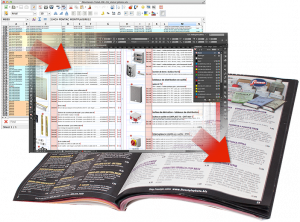

- Easycatalog 65bits install#
- Easycatalog 65bits update#
- Easycatalog 65bits software#
- Easycatalog 65bits Offline#
The InDesign catalog plugins are used to improve the work of graphic designers or marketing or sales departments by speeding up the process of importing product information into InDesign files. Why do I need an InDesign catalog plugin?

Easycatalog 65bits software#
The plugins add a whole series of automatic features that we do not find in the Adobe InDesign software and that make our work much easier such as importing product data and arranging them in the document following precise grouping logic chosen by the user.
Easycatalog 65bits update#
You can see what has been changed in a document and update only those fields. Print 2.0 can automatically flatten complex structures, so InDesign doesn't need to traverse a tree of relations, making it easier to build templates and execute production.
Easycatalog 65bits Offline#
Your designers can have the data in InDesign when working offline and synchronize it when they come back online. This no longer happens on a field-by-field basis like before, which tremendously improves the performance. Print 2.0 fetches all your data when you tell it to. Print 2.0 provides a modern REST API for the input and output of data to other systems. Print 2.0 can handle the transformation of HTML in different stages, using XSLT or other methods to adapt HTML used for web output to much simpler structures that work better in InDesign. You can create different configurations that contain formulas that compile data in the desired way, with no additional development. Data from fieldsets and specification templates can also be selected out of the box, depending on the main print entity. Data can be fetched from three entity relation levels higher or deeper than the main print entity, with no customization. The XML dataset can be compiled at the section level or any level below (for example subsection, or subsubsection). You can determine which Plan & Release structure level should be used to compile your dataset. Resources can be fetched according to the number of related resources, using specific relations indexes, or based upon resource metadata.

Multiple resourcesĭifferent formulas are available for resource handling. This all takes place in the background and can be tailor-made to suit your requirements. This reduces the time needed to gather information in InDesign. The same dataset can be used to create brochures, catalogs, and leaflets.

In Print 2.0, prints can be used in numerous ways to achieve a broad range of output. Tenants allow separation of brands and companies, with brands having access to their data without the risk of interference. This drastically improves InDesign performance. xml files, saved locally or on a shared server. Print does everything in real-time, which can result in slow content loading times in InDesign. You can use one or more fields to filter data from a dataset. Support for multiple languages, based on language usage in a geographical region (for example, support for Dutch, French, and German, on the Belgian market). In the newest version of Print, this plugin is the 65bit Eas圜atalog.Ĭomparison between functionalities of Print and Print 2.0 Functionality
Easycatalog 65bits install#
To connect Print to Adobe InDesign, you always need to install a plugin that allows the connection. Comparison tableīelow is a table comparing our old Print offering and the brand new Print 2.0. This article explains the differences between our newest Print offering and the old Print offering.


 0 kommentar(er)
0 kommentar(er)
